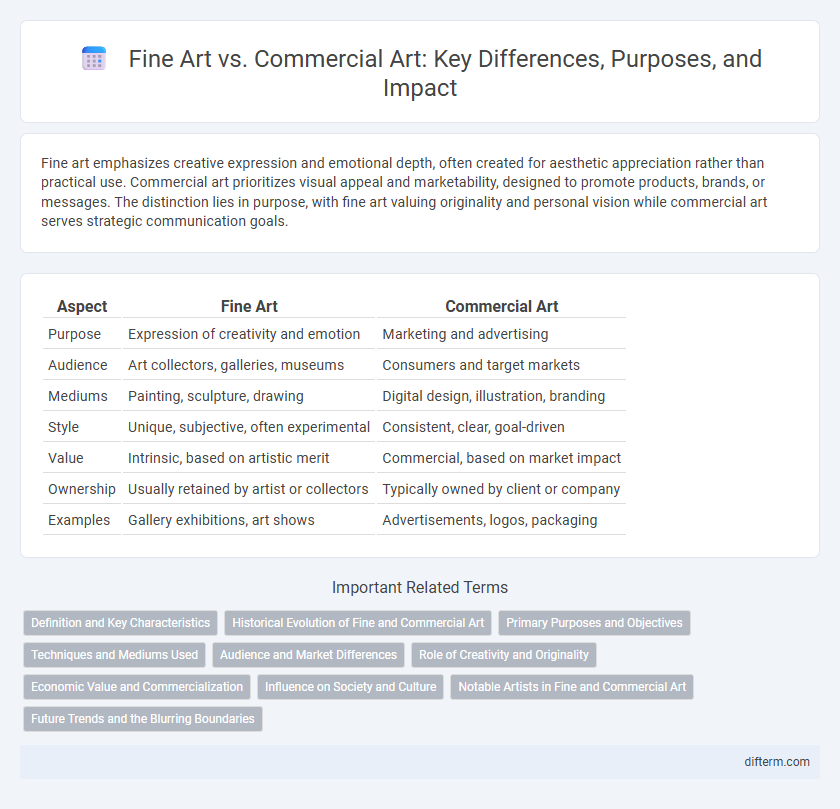Fine art emphasizes creative expression and emotional depth, often created for aesthetic appreciation rather than practical use. Commercial art prioritizes visual appeal and marketability, designed to promote products, brands, or messages. The distinction lies in purpose, with fine art valuing originality and personal vision while commercial art serves strategic communication goals.
Table of Comparison
| Aspect | Fine Art | Commercial Art |
|---|---|---|
| Purpose | Expression of creativity and emotion | Marketing and advertising |
| Audience | Art collectors, galleries, museums | Consumers and target markets |
| Mediums | Painting, sculpture, drawing | Digital design, illustration, branding |
| Style | Unique, subjective, often experimental | Consistent, clear, goal-driven |
| Value | Intrinsic, based on artistic merit | Commercial, based on market impact |
| Ownership | Usually retained by artist or collectors | Typically owned by client or company |
| Examples | Gallery exhibitions, art shows | Advertisements, logos, packaging |
Definition and Key Characteristics
Fine art emphasizes creative expression and aesthetic value, often created for appreciation and intellectual engagement without commercial intent. It typically includes painting, sculpture, and drawing, characterized by originality, emotional depth, and cultural significance. Commercial art focuses on visual communication for marketing purposes, including graphic design, advertising, and illustration, prioritizing client objectives, brand messaging, and mass appeal.
Historical Evolution of Fine and Commercial Art
Fine art originated in ancient civilizations, emphasizing aesthetic value and cultural significance through mediums like painting, sculpture, and architecture. Commercial art evolved during the Industrial Revolution, driven by mass production and advertising needs, integrating graphic design, illustration, and media to promote consumer goods. The historical evolution reflects the divergence in intent: fine art prioritizes personal and societal expression, while commercial art centers on communication and marketing strategies.
Primary Purposes and Objectives
Fine art centers on personal expression and the exploration of aesthetic and conceptual ideas, aiming to provoke emotional responses and cultural reflection. Commercial art prioritizes effective communication and persuasive messaging to promote products, services, or brands, often driven by market goals and client specifications. The primary objective of fine art is to evoke thought and appreciation, while commercial art focuses on function and consumer engagement.
Techniques and Mediums Used
Fine art predominantly employs traditional techniques such as oil painting, sculpture, and printmaking, emphasizing originality and expressive intent. Commercial art utilizes digital tools, graphic design software, and mixed media to produce visually compelling content aimed at advertising and marketing. Each field's choice of medium reflects its purpose: fine art prioritizes aesthetic and conceptual depth, while commercial art focuses on clarity and audience engagement.
Audience and Market Differences
Fine art targets collectors, galleries, and museums, with an emphasis on aesthetic value, emotional resonance, and cultural significance. Commercial art caters to businesses, advertisers, and mass audiences, focusing on functionality, brand messaging, and marketability. The market for fine art often involves exclusivity and high-value sales, while commercial art thrives on widespread distribution and repeated consumer engagement.
Role of Creativity and Originality
Fine art emphasizes creativity and originality as fundamental principles, aiming to provoke emotional and intellectual responses through unique, expressive works. Commercial art prioritizes creativity within the constraints of marketing goals, focusing on appealing to target audiences while maintaining originality to differentiate brands. Both realms value innovation, but fine art pursues artistic freedom, whereas commercial art balances creativity with strategic communication.
Economic Value and Commercialization
Fine art commands high economic value through its rarity, historical significance, and cultural impact, often selling at prestigious auctions and galleries. Commercial art prioritizes mass production and market appeal, generating steady income through advertising, packaging, and product design. The commercialization of fine art remains limited by exclusivity, while commercial art thrives on widespread distribution and consumer accessibility.
Influence on Society and Culture
Fine art drives cultural innovation by challenging societal norms and inspiring critical reflection through unique, expressive works that often become historical touchstones. Commercial art shapes consumer behavior and popular culture through visually persuasive designs aimed at marketing products and services, embedding brand messages in everyday life. Both forms significantly influence society by reflecting and molding collective values, though fine art emphasizes creative expression while commercial art prioritizes economic impact.
Notable Artists in Fine and Commercial Art
Notable artists in fine art include Leonardo da Vinci, Claude Monet, and Pablo Picasso, who are renowned for their innovative techniques and lasting influence on art history. In commercial art, figures like Andy Warhol and Roy Lichtenstein stand out for blending fine art aesthetics with advertising and mass media, transforming consumer culture through their work. The distinction emphasizes fine art's focus on personal expression and aesthetic value, while commercial art prioritizes branding, marketing, and audience engagement.
Future Trends and the Blurring Boundaries
The future of fine art and commercial art reveals increasing convergence through digital technologies like AI and virtual reality, enabling immersive, interactive experiences that challenge traditional definitions. NFTs and blockchain are transforming ownership and monetization, creating new revenue streams while democratizing art distribution. This blurring boundary fosters hybrid creative practices, where aesthetic expression and commercial viability coexist in evolving cultural landscapes.
Fine art vs commercial art Infographic

 difterm.com
difterm.com